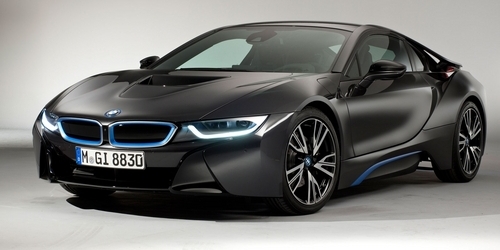
If you like sporty cars, do you like the look of the one above? Would you consider buying it at the bargain price of C$145,000? And if I told you that it can accelerate from 0 to 100 km/h in 4.4 seconds and has a top speed of 250 km/h, would that impress you? And that it can mobilize 362 horsepower to propel it? And now for the tough part. Can you accurately guess the fuel economy (mileage) you will get from this car?
- ❑ 2.1 litres/100km (112 mpg)?
- ❑ 6.5 litres/100km (36 mpg)?
- ❑ 9.1 litres/100km (26 mpg)?
- ❑ 11.1 litres/100km (21 mpg)?
- ❑ 15.7 litres/100km (15 mpg)?
I could not resist the temptation to adorn my blog with a picture of an innovative German-engineered car. The vehicle pictured above is the 2014 model of the BMW i8, a hybrid-electric vehicle. Not to be outdone by nascent Tesla Motors, BMW has come up with a vehicle that is both visually stunning and environmentlly pleasing. Now, if they could just lower the price by about $100,000, please.
In a previous blog, Our automotive future?, I had showcased the Volkswagen XL1 concept car. Unlike the XL1, the BMW i8 is hitting the market for real. Even though it is not winning a price for most-affordable car, it is on sale around the world.
Now for the answer to my question: if you checked "b", "c", "d", or "e", you were fooled by the looks of the car. As a plug-in hybrid-electric vehicle, the car achieves an astounding fuel economy of just 2.1 liters per 100 kilometres. The car has a 98-kilowatt electric motor that is supported by a 1.5-litre turbocharged gas engine with three cylinders.
Measuring fuel economy for hybrid-electric vehicles remains a bit of a challenge, however. European manufacturers test their vehicles with a standard known as the New European Driving Cycle (NEDC). The United States Environmental Protection Agency uses a different cycle to test fuel economy, and comes out somewhat less favourable. It lists it as 76 mpg (3.1 L/100km) in combined mode, and 28 mpg (8.4 L/100km) in gas-only mode.
It should be noted that the Tesla Model S provides slightly better acceleration and comes at roughly $64,500 for the cheapest version. The top model of the Tesla has a range of 460 km. The BMW i8 has an all-electric range of merely 25-35 km, but a combined total range of 600 km. This alleviates "range anxiety" of drivers. Neverthless, the challenge with charging remains perhaps one of the bigger obstacles to adopting electric vehicles and plug-in hybrid vehicles. BMW estimates the charging time at 2-2.5 hours.
The stunning looks of the vehicle hide an important innovation: the use of carbon-fiber-reinforced plastics for the passenger cell, which is sitting on top of the aluminium-based drive chassis. This results in a low curb weight of 1,486 kg. This compares favourable with the Tesla Model S, whose curb weight is 2,108 kg—42% higher than the BMW i8. The key to environmental performance is weight, and BMW has understood this importance.
Further readings:
- Mark Hacking: Why BMW's $145,000 i8 hybrid sports car is a bargain, The Globe and Mail, April 28, 2014.
- Graeme Fletcher: Supercar Review: 2015 BMW i8, Driving magazine, April 27, 2014.
- We drive the 2015 BMW i8 plug-in hybrid performance car, Autoweek, January 2, 2014.
![[Sauder School of Business]](logo-ubc-sauder-2016.png)
![[The University of British Columbia]](logo-ubc-2016.png)